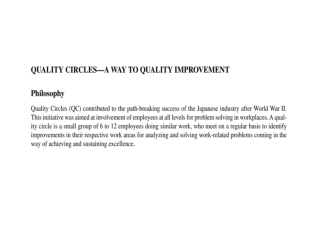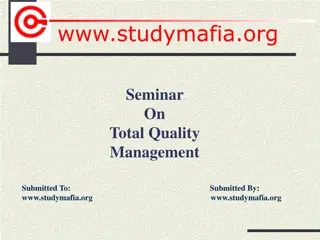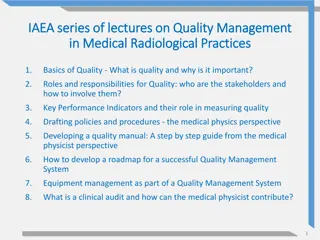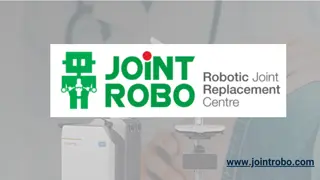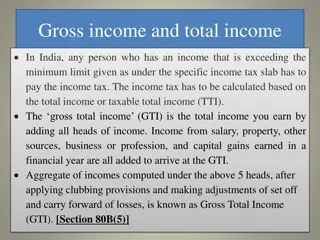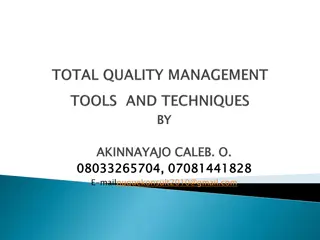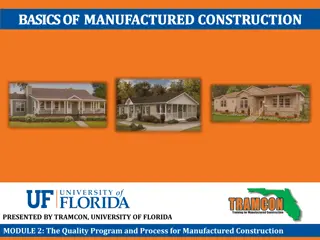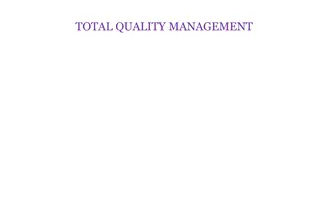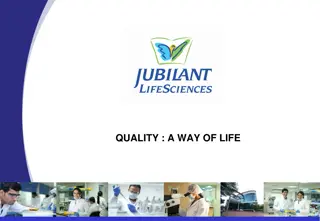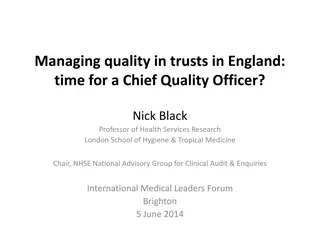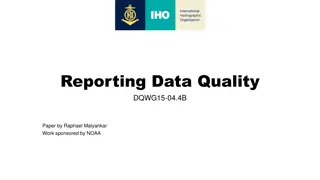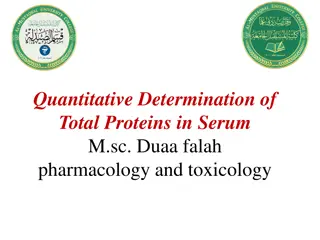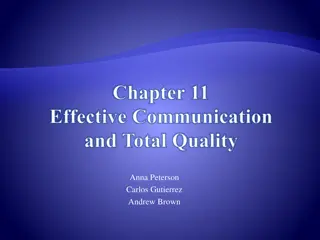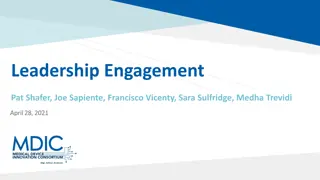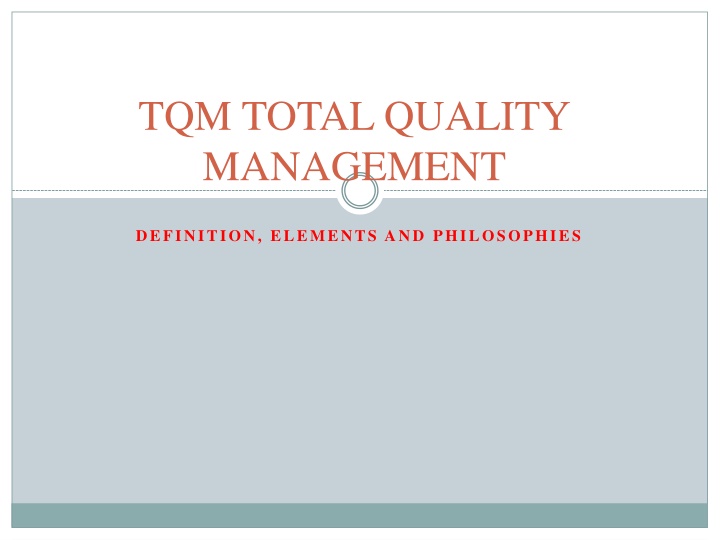
Total Quality Management: Definition, Principles, and Elements
Learn about Total Quality Management (TQM), a customer-oriented process focusing on continuous improvement in business operations. Explore the principles of TQM, such as management commitment, employee empowerment, continuous improvement, and customer focus. Discover the essential elements of TQM including ethics, integrity, teamwork, leadership, and more.
Download Presentation

Please find below an Image/Link to download the presentation.
The content on the website is provided AS IS for your information and personal use only. It may not be sold, licensed, or shared on other websites without obtaining consent from the author. If you encounter any issues during the download, it is possible that the publisher has removed the file from their server.
You are allowed to download the files provided on this website for personal or commercial use, subject to the condition that they are used lawfully. All files are the property of their respective owners.
The content on the website is provided AS IS for your information and personal use only. It may not be sold, licensed, or shared on other websites without obtaining consent from the author.
E N D
Presentation Transcript
TQM TOTAL QUALITY MANAGEMENT DEFINITION, ELEMENTS AND PHILOSOPHIES
TQM Definition: TQM is customer oriented process, aims for continuous improvement of business operations. TQM ensures all allied works are towards the common goals of improving product quality or service quality, enhancing the production process or process of giving best services. TQM is Fact based decision making & use of performance metrics to monitor progress Concept developed in Japan in late 1940 s & 1950 s John Gilbert: A process designed to focus on customer expectations, preventing problems, building commitment to quality in the workforce & promoting open decision making. W. Edwards Deming & Joseph M. Juran developed the concept of TQM
PRINCIPLES OFTQM Commitment from MANAGEMENT: Plan (drive & direct), Do (deploy, support, participate) Check (review), Act (recognize, communicate, revise) Employee Empowerment: Training, Excellence team, Measurement & recognition, Suggestion scheme Continuous improvement: Systematic measurement, Excellence teams, Cross functional process management, Attain, maintain, improve standards Customer Focus: Partnership with suppliers, service relationship with internal customers Customer driven standards, Never compromise quality
ELEMENTS OF TQM Foundation Ethics, Integrity, Trust Building Bricks Training Teamwork Leadership TQM Roof Recognition Binding Mortar Communica tion
Ethics: Organizational & individual ethics Teach to follow code of conduct of organization & adhere to rules & regulations Integrity: Means honesty, morals, values, fairness & adherence to facts & sincerity Respect your organization s policies, Avoid spreading unnecessary rumors about fellow workers TQM does not work where employees criticize & back stab each other TRUST: Employees should trust each other to ensure participation of all Improves relationship for better decision making Builds cooperative environment essential for TQM Training: Awareness about benefits of TQM, making difference in product quality, yield profits, Interpersonal skills, ability to work as a team members, technical know how, decision making skills, problem solving skill etc TEAMWORK: Business receives quick solutions to problems Permanent improvements in processes & operations Team solves the problems, provides solutions
Types of Teams 1. Quality improvement team : Temporary, deals with specific problems 2. Problem solving team: Temporary, identify & overcome 3. Natural working team : Small group of skilled workers shares tasks & responsibilities LEADERSHIP: Provides direction to entire process of TQM Supervisor: is the Source of inspiration, who assists in decision making Leader to believe in TQM process & make others COMMUNICATION: Binds together from foundation to roof of TQM Link b/w elements of TQM Understanding of ideas b/w sender & receiver Success of TQM depends, among organizational members, suppliers & customers DOWNWARD COMMUNICATION: Dominant form, flow of information from management to employees UPWARD COMMUNICATION: Lower level of employees provide suggestions to upper management, flow from employees to top level management
RECOGNITION: Final element of TQM Acts as catalyst & drives employees to work hard as a team Everyone needs appreciation and recognition Should reward the best ideas, brilliant ideas
PHILOSOPHIES OF TQM W. Edwards Deming: Father of QC Statistician at New York in 1940 s Deming prize : Annual award to firms with outstanding quality Quality is direct result of quality of design, quality of conformance & quality of sales & service Developed set of 14 points for management, QM is responsibility of all Managers must change, develop partnership with operating level of business Advocated PDCA: Plan, DO, Check and Act Walter A Shewhart: Grand father of QC Statistician at Bell Labs 1920-30 s Studied randomness & recognized variation takes place in all the manufacturing processes. Developed QC charts, to identify variation in process is random or due to some cause like poor workers or mis-calibrated machinery Laid foundation of Statistical Process control (SPC)
PHILOSOPHIES OF TQM Dr. Joseph M Juran: 1951, Quality control handbook Def. Quality: Fitness for Use, Cost of quality 10 point plan backbone of TQM 1. Build awareness of need & opportunity for improvement 2. Set goals for improvement 3. Organize to reach the goals 4. Implement continuous improvement. workers need to be Provided training on regular basis 5. Carry out projects to solve problems 6. Report progress 7. Give recognition 8. Communicate results 9. Keep score 10. Maintain momentum by making annual improvement Trilogy Quality Planning Customers, product req. overriding business goals Quality Control Regular use of Statistical control methods, identify variation from standards Quality Improvement Be continuous as well as breakthrough
PHILOSOPHIES OF TQM Armand V Feigenbaum 1961- Book on TQC Quality principles in 40 steps Idea of work environment Total commitment to improve quality Company wide QC philoso. Quality can be improved only by participation of all Clear customer oriented QM Goal of quality improvement reduce the total cost of quality to as low a % as possible 4 steps to quality Set quality standards Appraise conformances to standards Act when standards are not met Plan to make improvement Benchmarks to Total Q Success Company wide, what customer says, Quality and cost are sum not difference, requires both team and individual zeal, way of managing, ethic, req. continuous improvement, cost effective, least capital intensive route to productivity
PHILOSOPHIES OF TQM Philip B Crosby: Guru TQM Do it right the first time Zero defects No amount of defects acceptable Idea of prevention Book Quality is free-1979 Quality means conformance not elegance No such thing as quality problem Quality is inherent of product not added extra Workers should not be blamed of errors, management should lead and workers to follow Methods for QM - Establish Mgt . Commitment -Form quality improvement teams -Establish Quality measurements - Evaluate cost of quality - Raise quality awareness -Take actions to correct problems - Zero defects planning - Train supervisors & Managers -Hold a Zero defects day Encourage setting of goals for improvement - Obstacle reporting -Recognition for contributors - Establish QC -Do it all over again
PHILOSOPHIES OF TQM KAORU ISHIKAWA: Father of Quality circles (small team of employees) Founder of Japanese quality movement Development of quality tools cause-and-effect diagrams - fishbone or Ishikawa diagrams Used for quality problem solving Emphasized on internal customer, the next person in the production process First to stress importance of total company quality control rather than focusing on products & services Everyone in company needs to be united with shared vision & common goal Quality circle is a voluntary group of employees works on similar tasks or share an area of responsibility Meets on regular basis, discuss & solve problems related to work Principle: Participation of employee in decision making & problem solving to improve quality of work No. of people 3-12 Specific issues to resolve Meets once a week to analyze
PHILOSOPHIES OF TQM KAORU ISHIKAWA Basic elements to constitute structure of quality circle Top management 2. Steering committee 3. Coordinator 4. Facilitator 5. Leader 6. Members 7. Non members 1.
Seven tools of quality control: Kaoru ishikawa Tool Type 1 Pareto charts To identify the principal causes of problems 2 Fishbone diagrams Charts of cause & effect in process 3 Stratification layer charts Charts which place each set of data successively on top of previous one 4 Check sheets To provide record of quality 5 Histograms Used to display frequency of various ranges of values of a quality 6 Scatter Graphs Used to help determine whether there is a correlation between two factors 7 Control charts Used as a device in statistical process control
PHILOSOPHIES OF TQM Genichi Taguchi: Japanese expert Area of work: product design 80% of all defective items are due to poor design Focus should be at design stage being cheaper and easier to make changes during product design stage than later during production process Design of experiments (DOE) to product design concept- Robust design so that products perform over a wide range of conditions

